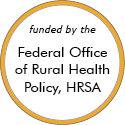Rural Project Examples: Wellness, health promotion, and disease prevention
Promising Examples
ALProHealth
Updated/reviewed March 2023
- Need: To improve access to healthy food and physical activity in rural Alabama.
- Intervention: Researchers hold focus groups with community members to identify issues of the most concern and then help them implement appropriate interventions like installing playground equipment.
- Results: From 2014 to 2018, 14 coalitions implemented 101 interventions in 16 communities.
Contingency Management Smoking Cessation in Appalachia
Updated/reviewed June 2022
- Need: To reduce smoking rates of pregnant women and adolescents in Appalachian regions of eastern Kentucky and Ohio.
- Intervention: A web-based smoking cessation program that offered monetary incentives to reducing smoking.
- Results: Participants significantly reduced smoking rates or quit altogether.
School-Based Health Center Dental Outreach

Updated/reviewed July 2020
- Need: To improve the oral health status of children ages 3 to 17 living in rural areas of Louisiana.
- Intervention: School-based nurse practitioners perform oral health assessments, apply fluoride varnishes when indicated, and make dental referrals, with completion rates of the latter tracked by dental case managers.
- Results: Significant numbers of school children are receiving oral health examinations, fluoride varnish applications, and receiving care coordination to improve numbers of completed dental appointments.
Youth4Health

Updated/reviewed December 2019
- Need: To educate youth about obesity and healthy lifestyle choices.
- Intervention: An educational program about healthy living was implemented in Lincoln and Claiborne Parishes in Louisiana for youth ages 9-18.
- Results: Youth4Health program produced greater awareness and participation in healthier lifestyles by target youth and their families, as well as church congregations.
Other Project Examples
Healthy Adams County
Updated/reviewed November 2025
- Need: To create initiatives in rural Pennsylvania communities to address locally-identified health disparities.
- Intervention: Healthy Adams County was created by Adams County residents to promote community-wide health.
- Results: Community task forces have been formed to address healthcare access, female cancers, food policies, behavioral health, children's health & nutrition, domestic violence/sexual assault, and other community-identified needs.
Healthy Monadnock Alliance
Updated/reviewed November 2025
- Need: Improved health outcomes for Monadnock Region, a rural area of New Hampshire.
- Intervention: A wide-scale effort across multiple sectors is aiming to improve health outcomes throughout the region.
- Results: Community health trends have been tracked over time, and progress on goals such as increasing the number of residents with healthcare coverage, opportunities for physical activity, access to healthy foods, and smoking cessation has been made.
One Health Recovery Doulas

Updated/reviewed November 2025
- Need: To support pregnant and parenting women with a history of substance use, mental health, or co-occurring disorders in rural areas of Montana.
- Intervention: One Health, a consortium of Federally Qualified Health Centers (FQHCs), developed a team of "recovery doulas" – individuals who are dual-certified as doulas and peer-support specialists. The One Health recovery doula program offers group and individual services to women and their partners from pregnancy through the first years of parenthood.
- Results: A team of four recovery doulas (or doulas-in-training) employed by One Health offer services in 8 rural eastern Montana counties. One Health has also successfully trained and certified 35 Peer Recovery Doulas statewide through their Peer Recovery Doula certification curriculum.
Win With Wellness

Updated/reviewed October 2025
- Need: To reduce risk of obesity and chronic disease in rural northwest Illinois.
- Intervention: Win With Wellness (WWW) collaborated with community organizations and worksites to improve physical activity and eating behaviors and reduce weight among adults using a multi-component approach.
- Results: From 2015 to 2018, the two participating counties initiated 28 Take Off Pounds Sensibly (TOPS) groups with 367 participants. In the second round of funding, WWW recruited 183 participants for 9 TOPS groups and 8 community Heart-to-Heart sites.
Schools as a Hub for Health
Updated/reviewed September 2025
- Need: To improve health outcomes in rural Appalachian Ohio.
- Intervention: Schools as a Hub for Health promoted holistic wellness for the whole community by creating or bringing in programs that support physical, mental, and social health.
- Results: The project gained administrator buy-in and facilitated the development of a variety of health-focused school-based programs.
It's a Girl Thing: Making Proud Choices
Updated/reviewed June 2025
- Need: Teen pregnancy, sexually transmitted diseases, and mental health challenges in adolescent girls were concerns for members of Union Parish, Louisiana.
- Intervention: Union General Hospital, a Critical Access Hospital, created the program It's a Girl Thing: Making Proud Choices to teach prevention, self-confidence, personal responsibility, and mental well-being to teen girls.
- Results: Teen pregnancy rates in Union Parish have dropped by more than 40% since the start of the program, significantly exceeding the program's initial goal of 5%. Graduation rates have also increased. The addition of Together We Can Be Bully Free as an integral part of It's a Girl Thing has further expanded mental health support for participants.
For examples from other sources, see:
